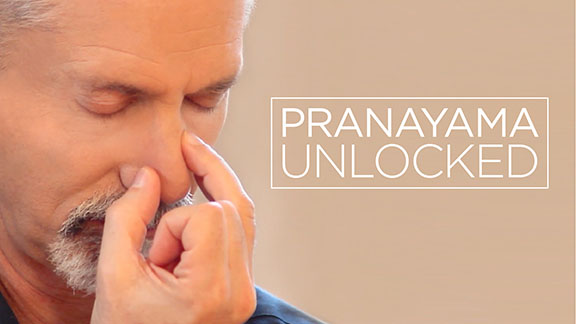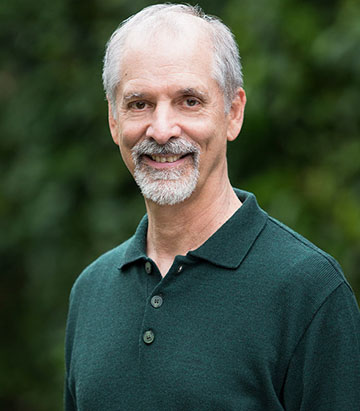 Gary Kraftsow asserts that pranayama is among the most uniquely potent parts of Yoga practice. He explains that there’s no other tradition that has the sophistication of the yogic science of breath. In this article, he eloquently explains the ways you can use pranayama to create the effects you want in your practice. He shows how your asana practice can serve your pranayama practice, your pranayama practice can serve your asana practice and both practices together can serve your meditation practice.
Gary Kraftsow asserts that pranayama is among the most uniquely potent parts of Yoga practice. He explains that there’s no other tradition that has the sophistication of the yogic science of breath. In this article, he eloquently explains the ways you can use pranayama to create the effects you want in your practice. He shows how your asana practice can serve your pranayama practice, your pranayama practice can serve your asana practice and both practices together can serve your meditation practice.
The Three Stages of Life
Most Yoga practitioners today are in what we would call the midday stage of life. This is an image used in Viniyoga: sunrise being the first 25 or 30 years of life, midday being that long period extending up into the mid-70s and the sunset stage of life usually comes after the age of 75. In the sunrise stage of life, the focus of our practice is on asana with a primarily structural orientation. In the midday stage of life, asana, adapted in service of deepening the breath and as preparation for pranayama, is the recommended focus of our practice. I often use the metaphor of dental hygiene to explain this principle. If you ask a young person, “What’s more important: your teeth or your gums?,” the usual answer is “teeth.” As we get older, we realize that, though the teeth are important, the gums are often more important for our health. In the same way, we can ask the question, “Which is more important: your hamstrings or your liver?” Although the hamstrings are important, it’s obvious to most people, as they get older, that the condition of their liver is far more important in the big picture.
These are the metaphors for the shift of focus from structurally centered asana to breath-centered asana and pranayama. Breath-centered asana practice and pranayama are among the greatest gifts from the Yoga tradition that help us maintain our physiological and metabolic health and well-being. In the sunset stage of life, movement (asana) and breath (pranayama) are still recommended, but they are adapted to support meditation, ritual and prayer. These practices are designed to help us resolve all issues and to prepare for the inevitable transition from life to death. It is our goal to be able to reach the end of our lives with a sense of peace, happiness and fulfillment rather than regret, resentment and fear.
Three Intentions for Pranayama Practice
When you begin to practice, having a clear intention and orientation will help shape the choices and provide direction for your practice. The next important step is to be fully present when you are practicing—not distracted or thinking about other things. With clear intention and focused attention, learn how to control the flow of inhalation and exhalation and how to use this to mobilize the spine. Then learn how the conscious use of the breath creates the stillness of mind required for meditation. Learn to use the breath to activate the process of transformation, which is the promise of Yoga.
- Asana as preparation for pranayama: Our focus is not about the structural details of the asana—we are preparing the body and breath for pranayama. In this breath-centric asana, the emphasis is on controlling and lengthening the inhale and exhale and on the appropriate use of retention of breath after inhalation and suspension of breath after exhalation in specific parts of asana practice.
- Pranayama as compensation for asana: If our focus is to do deep, strong asana, then pranayama is useful to help integrate the experience, bringing our metabolism back to neutral and giving our minds and bodies time to absorb the effects of the asanas. We utilize simple, light breathing to bring back balance to help transition between strong asana practice and the rest of our day.
- Asana and pranayama as preparation for meditation: We can use asana with pranayama, in equal value, in service of chanting, mantra japa or meditation. For example, we might use breath control in asana, regulating the length of the breath by the mental recitation of our mantras. Linking the mantra to the breath takes the mantra beneath the level of the superficial, or ordinary waking state to a deeper part of your consciousness. The asanas and pranayama combine to take either the object of your meditation or your mantra deeper into your system.
Six Building Blocks of a Pranayama Practice
- Directional flow of the breath: In the Viniyoga tradition, there are multiple ways to control the flow of the breath and each has a different effect. The job of the teacher or practitioner is to adapt the breathing in such a way that it supports the intention of the practice. For example, if we want to increase the axial extension of the spine, we emphasize inhalation with chest expansion. If we are agitated and want to calm the system, we might emphasize letting the belly gently protrude on the inhalation. When we are expanding the chest on inhalation, the effect is more in the direction of what we call brahmana—to expand, energize or nourish. When we expand our belly on inhalation, the effect is more in the friction of what we call langhana—to reduce or eliminate and ground one’s energy.
- Breath threshold: We breathe 15-20 breaths per minute. If we breathe 20 breaths a minute, the duration of the cycle of inhale-exhale is 3 seconds. If, when practicing pranayama, our inhalation is 10 seconds, retention after the inhale is 5 seconds, exhale 10 seconds and then suspension of breath after exhale 5 seconds, that’s 30 seconds per cycle. From 20 breaths per minute, we have reduced the number of breaths to 2! According to Sri Krishnamacharya’s teachings, we can measure our breath threshold by how far we can reduce the number of breaths per minute—not one time, but consistently—over a dozen breaths. Discovering our current breath threshold and expanding it over time is extremely beneficial. Physiologically, expanding breath threshold is the doorway to sympathetic/parasympathetic regulation and, through that, overall health and balance in our physiological functioning. Psychologically, this will also help us to balance our emotions and clarify our minds.
- Complex science of ratio: There are 4 parts of a Yoga breath cycle: inhalation, retention after inhalation, exhalation and suspension of breath out after exhalation. There’s a science of ratio, or the proportional relationship between these 4 parts of the breath, that determines the overall effect of the practice. If we want to emphasize sympathetic activation, a more brahmana ideal, then we might emphasize progressively increasing the length of retention after inhale during the practice. On the other hand, progressively lengthening the exhalation will have a more langhana effect. This is a complex science that has some risks and it should be practiced under the guidance of a qualified teacher.
- Techniques: There are various techniques that can be organized and categorized by where and how the flow of the breath is controlled or “valved.” These techniques place the “valve”—by which we control the flow of the breath—either in the throat (ujjayi), at the right or left nostril (nadi shodhana) or at the tongue (sitali). The names of various techniques define the placement of the valve, and these valves produce different effects: heating (surya, sun) and cooling (chandra, moon). Like ratio, the science of technique is complex and is best practiced under the guidance of a qualified teacher.
- Placement of the mind: Our practices are very influenced by how we focus our minds. If we are using pranayama to support a deeper understanding of our asana practice, we might focus primarily on the relation between the flow of the breath and the movement of our spines during practice. If we are using our practice to promote sympathetic/parasympathetic balance and adapt a specific technique to achieve that end, we might keep our focus on the sound and effect created at the valve site. Or, if we are using our practice to support a mantra and meditation practice, then our focus should be on that mantra during practice. The various ways in which we can modify our method of practice should emerge from a clear intention for the practice itself plus an understanding of how the adaptations produce different effects.
- Relationship between asana and pranayama: If our goal is to do a brahmana pranayama (an energizing practice), we might choose to include in our preparation a standing back bend—like virabhadrasana—and, in that pose, lengthen inhalation and add a short retention after inhalation. Or, if our goal is to do a langana pranayama—a relaxing practice, then we might include in our preparation a seated twist like ardha matsyendrasana and, in that pose, lengthen the exhalation and add a short suspension after exhalation. These examples illustrate how to choose specific postures and adapt the breathing in those postures to prepare both the body and breath for a specific pranayama. The theory is that we intentionally choose both the asanas and breath adaptation in those asanas that will most effectively prepare us for our pranayama practice. Thus, we are using asana and pranayama to produce a particular psycho-physiological effect.
As we have seen, pranayama can be utilized to prepare the body and breath for pranayama practice, to bring the body back to neutral after asana, for its own physiological effects and as a preparatory step to lead the mind and heart into deeper meditation. I wish you all may deepen your understanding of this profound and extraordinary practice, embrace it and make pranayama a core part of your practice.
From Integral Yoga Magazine, Fall 2010

Gary Kraftsow has been a pioneer in the transmission of Yoga for health, healing and personal transformation for over 40 years. He began his study of Yoga in India with T.K.V. Desikachar in 1974 and received a Viniyoga Special Diploma from Viniyoga International in Paris, France in 1988. Gary has successfully developed protocol for two National Institutes of Health studies: “Evaluating Yoga for Chronic Low Back Pain” and “Yoga Therapy for Generalized Anxiety”, as well for the “Mind-Body Stress Reduction in the Workplace” clinical trial for Aetna Insurance Company. He is the Director and Senior Teacher of the American Viniyoga Institute™ (AVI), the author of two books published by Penguin: Yoga for Wellness and Yoga for Transformation, and author of four educational DVD’s: Viniyoga Therapy for Low Back, Sacrum and Hips and Viniyoga Therapy for Upper Back, Neck and Shoulders, Viniyoga Therapy for Depression, and Viniyoga Therapy for Anxiety. He has also produced several online workshops: Pranayama Unlocked, Meditation Unlocked, and Yoga Therapy for Depression.

